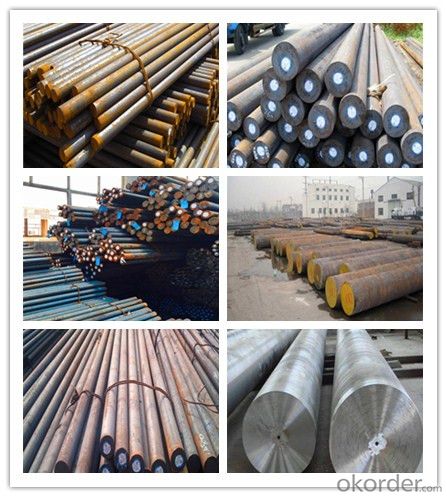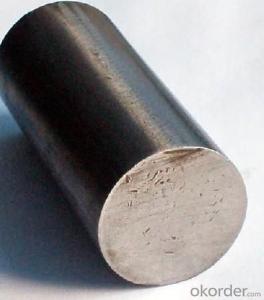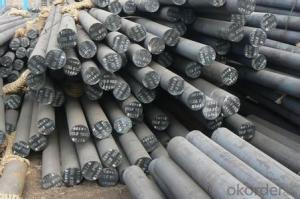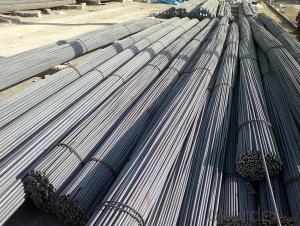High Carbon Steel Bearing Round Bar GCr15
- Loading Port:
- Shanghai
- Payment Terms:
- TT OR LC
- Min Order Qty:
- 100 m.t.
- Supply Capability:
- 50000 m.t./month
OKorder Service Pledge
OKorder Financial Service
You Might Also Like
Item specifice
High Carbon Steel Bearing Round Bar GCr15
Product Description of High Carbon Steel Bearing Round Bar GCr15
1. Steel grade: ASTM52100, SUJ2, 100Gr6,GCr15
2. Length: 6M-12M
3. Diameter: 16mm-300mm
4. Product range: round bar, flat bar, square bar, wire rod, sheet
5. Technique: Hot rolled, forged, cold drawn
Specification of High Carbon Steel Bearing Round Bar GCr15
Material | GCr15 | Round bar | Dia(mm) | 10-300mm |
Process | EAF + LF + VD + Forged + Heat Treatment (optional) | Length (mm) | Max 12m | |
Heat treatment | Normalized / Annealed / Quenched / tempered | Flat bar | Thickness(mm) | 8-500mm |
Delivery condition | Hot forged +Rough machined (black surface after Q/T)+ Turned (optional) | Width(mm) | 70-200mm | |
Test | Ultrasonic test according to SEP 1921-84 D/d | Length (mm) | Max 12m |
Chemical Composition of High Carbon Steel Bearing Round Bar GCr15
C | Si | Mn | Cr | Ni | Mo | P | S |
0.95~1.05 | 0.15~0.35 | 0.25~0.45 | 1.40~1.65 | ≤0.30 | ≤0.10 | ≤0.025 | ≤0.025 |
Photo Show of High Carbon Steel Bearing Round Bar GCr15

Packing and Delivery:
Packing in bundle package, or as customer's requirements.
Delivery Detail: 45 days after receiving the deposit.
Usage and Applications of High Carbon Steel Bearing Round Bar GCr15
1. Steel round bar is used in a large number of architectural and engineering structures. Or it can be used in construction of plants for the production of steel house frames, high-voltage transmission towers, bridges, vehicles, boilers, containers, ships, etc.
2. And we can use this kind of product on the performance of the mechanical parts if the demand is not very high.
3. Some special material steel round bar can be used for main shaft of steamer, hummer shank, with big section and supper force.
Company Information
CNBM International Corporation is the most important trading platform of CNBM group.
Whith its advantages, CNBM International are mainly concentrate on Cement, Glass, Iron and Steel, Ceramics industries and devotes herself for supplying high qulity series of refractories as well as technical consultancies and logistics solutions.


F A Q
1, Your advantages?
professional products inquiry, products knowledge train (for agents), smooth goods delivery, excellent customer solution proposale
2, Test & Certificate?
SGS test is available, customer inspection before shipping is welcome, third party inspection is no problem
3, Factory or Trading Company?
CNBM is a trading company but we have so many protocol factories and CNBM works as a trading department of these factories. Also CNBM is the holding company of many factories.
4, Payment Terms?
30% TT as deposit and 70% before delivery.
Irrevocable L/C at sight.
5, Trading Terms?
EXW, FOB, CIF, FFR, CNF
6, After-sale Service?
CNBM provides the services and support you need for every step of our cooperation. We're the business partner you can trust.
For any problem, please kindly contact us at any your convenient time.
We'll reply you in our first priority within 24 hours.
- Q:How do you calculate the fatigue strength of a steel round bar?
- Various methods can be employed to calculate the fatigue strength of a steel round bar. For instance, the stress-life (S-N) curve approach or the strain-life (ε-N) curve approach can be utilized. The stress-life (S-N) curve approach entails plotting the stress amplitude (S) against the number of cycles to failure (N) on a log-log scale. By subjecting multiple specimens of the steel round bar to different stress levels and measuring the number of cycles to failure for each stress level, the S-N curve can be obtained. The fatigue strength of the steel round bar can then be determined by identifying the stress level at which the desired number of cycles to failure is achieved, commonly known as the endurance limit. On the other hand, the strain-life (ε-N) curve approach involves plotting the strain amplitude (ε) against the number of cycles to failure (N) on a log-log scale. Similar to the S-N curve approach, multiple specimens of the steel round bar are subjected to different strain levels, and the number of cycles to failure is recorded. By utilizing the strain-life curve, the fatigue strength can be determined by identifying the strain level corresponding to the desired number of cycles to failure. It should be emphasized that calculating the fatigue strength of a steel round bar necessitates conducting fatigue tests on representative specimens under controlled conditions. These tests involve subjecting the specimens to cyclic loading, typically in the form of tension-compression cycles, and recording the number of cycles to failure. The data obtained from these tests is then utilized to construct the S-N curve or the ε-N curve, which offers valuable insights into the fatigue behavior and strength of the steel round bar.
- Q:Can steel round bars be used for making kitchen utensils?
- Yes, steel round bars can be used for making kitchen utensils. Steel is a strong and durable material that is commonly used in the production of kitchen utensils due to its resistance to corrosion, heat, and chemical damage. Steel round bars can be easily shaped and molded into various utensils such as spoons, forks, knives, and ladles. Additionally, steel utensils are non-reactive, which means they do not leach harmful substances into food, making them a safe choice for cooking and food preparation.
- Q:What is the maximum hardness achievable for steel round bars?
- The maximum hardness achievable for steel round bars depends on various factors such as the composition of the steel, the heat treatment process, and the desired properties for the specific application. Generally, steel can achieve a maximum hardness of around 65 HRC (Rockwell Hardness Scale C) or higher. This level of hardness is typically obtained through processes like quenching and tempering. Quenching involves rapidly cooling the steel from a high temperature to room temperature, which results in a hardened structure. Tempering is then performed to reduce the brittleness and improve the toughness of the steel while maintaining a high level of hardness. It's important to note that increasing the hardness of steel beyond a certain point may lead to reduced toughness and increased brittleness. Therefore, the maximum achievable hardness should be balanced with the desired properties for the specific application, such as strength, ductility, and resistance to wear or impact.
- Q:What are the different testing methods used for steel round bars?
- The different testing methods used for steel round bars include dimensional inspection, visual inspection, ultrasonic testing, magnetic particle inspection, dye penetrant inspection, hardness testing, and chemical analysis.
- Q:What are the advantages of using magnesium-alloy steel round bars?
- One advantage of using magnesium-alloy steel round bars is their high strength-to-weight ratio. These bars offer excellent strength and durability while being lightweight, making them suitable for applications where weight reduction is crucial, such as in aerospace and automotive industries. Furthermore, magnesium-alloy steel round bars exhibit good corrosion resistance, which extends their lifespan and makes them ideal for outdoor and marine applications. Additionally, these bars can be easily machined and formed, allowing for flexibility in design and fabrication processes.
- Q:Can steel round bars be used in the automotive manufacturing industry?
- Yes, steel round bars can be used in the automotive manufacturing industry. They are often utilized for various applications, such as the production of engine components, suspension systems, and structural parts. Steel round bars offer excellent strength, durability, and machinability, making them suitable for meeting the demanding requirements of the automotive industry.
- Q:Why is it better to use round steel than flat steel in lightning protection?
- From the cross section, thermal stability as long as meet the discharge current can be, but from the lightning protection downlead selection, selection of round steel in order to prevent the tip discharge, so we generally do not choose flat edges as grounding, buried in the earth round and not flat how much difference, but in the case of the same section
- Q:What's the difference between round steel and other steel bars?
- Different appearance, round steel appearance garden, no grain without rib, other steel surface has carved or ribbed. This causes the round bar and concrete bonding force is small, and other steel and concrete bonding force
- Q:What is the typical lead time for manufacturing steel round bars?
- The lead time for manufacturing steel round bars can vary depending on different factors, including the bars' size and quantity, the complexity of the manufacturing process, and the manufacturer's production capacity. Typically, manufacturing steel round bars takes anywhere from a few days to several weeks. When it comes to standard sizes and quantities, the lead time is usually shorter since manufacturers keep them in stock. However, custom orders or larger quantities require additional processes such as sourcing raw materials, cutting, heat treating, and quality control checks, which can extend the lead time. It's important to consider that market demand and the manufacturer's production schedule can also impact lead times. During periods of high demand or limited production capacity, lead times may be longer. Conversely, during times of low demand or surplus production capacity, lead times can be shorter. To get an accurate estimate of the lead time for manufacturing steel round bars, it is recommended to directly contact specific manufacturers or suppliers. They will be able to provide more precise information based on their capabilities and current workload.
- Q:What are the different heat treatment methods for steel round bars?
- Steel round bars can undergo various heat treatment methods to enhance their mechanical properties and overall performance. These methods, namely annealing, normalizing, quenching, tempering, and case hardening, are commonly employed. 1. Annealing: By subjecting the steel round bars to a specific temperature and maintaining it for a certain duration, annealing achieves a uniform microstructure. This treatment alleviates internal stresses, improves ductility, and enhances machinability. 2. Normalizing: This technique involves heating the steel round bars slightly above their critical transformation temperature and subsequently cooling them in still air. Normalizing refines the grain structure, enhances mechanical properties, and improves resistance to impact and fatigue. 3. Quenching: The process of quenching entails heating the steel round bars above their critical temperature and rapidly cooling them by immersion in a quenching medium like oil, water, or brine. This rapid cooling hardens the steel, rendering it stronger and more resistant to wear and abrasion. However, quenched steel may exhibit brittleness, necessitating additional heat treatment steps. 4. Tempering: Following the quenching process, tempering is often employed to reduce brittleness and enhance toughness. Tempering involves reheating the quenched steel to a specific temperature and holding it there for a designated time, followed by gradual cooling. This procedure alleviates internal stresses, improves ductility, and enhances overall toughness and machinability. 5. Case Hardening: Case hardening is a surface heat treatment method that increases the hardness of the outer layer of steel round bars while maintaining a relatively softer core. This technique involves heating the steel in a carbon-rich environment, such as a gas or salt bath, and subsequently quenching it to achieve a hardened outer layer. Case hardening improves wear resistance and fatigue strength, making it suitable for applications requiring high surface hardness. It is crucial to note that the selection of the specific heat treatment method for steel round bars depends on the desired mechanical properties and intended application. Manufacturers meticulously choose the appropriate heat treatment method based on factors such as steel composition, desired hardness, and required strength.
1. Manufacturer Overview |
|
|---|---|
| Location | |
| Year Established | |
| Annual Output Value | |
| Main Markets | |
| Company Certifications | |
2. Manufacturer Certificates |
|
|---|---|
| a) Certification Name | |
| Range | |
| Reference | |
| Validity Period | |
3. Manufacturer Capability |
|
|---|---|
| a)Trade Capacity | |
| Nearest Port | |
| Export Percentage | |
| No.of Employees in Trade Department | |
| Language Spoken: | |
| b)Factory Information | |
| Factory Size: | |
| No. of Production Lines | |
| Contract Manufacturing | |
| Product Price Range | |
Send your message to us
High Carbon Steel Bearing Round Bar GCr15
- Loading Port:
- Shanghai
- Payment Terms:
- TT OR LC
- Min Order Qty:
- 100 m.t.
- Supply Capability:
- 50000 m.t./month
OKorder Service Pledge
OKorder Financial Service
Similar products
New products
Hot products
Related keywords


































